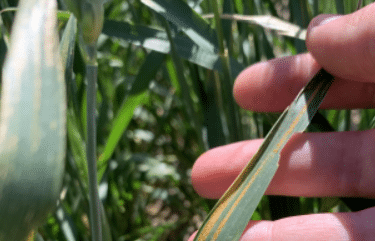MSU Extension-Stripe rust has arrived in our state! Stripe rust has been observed on winter wheat research plots at the Eastern Agricultural Research Center in Sidney, as well as the Northwestern Agricultural Research Center in Creston, Montana. In addition, we have received samples and reports of stripe rust from northcentral Montana (Chouteau County). With winter wheat flag leaves out and the crop at the flowering stage in most parts of the state, the spring wheat crop not far behind, and the weather forecast predicting a spell of cooler temperatures and more moisture (at least for southwestern Montana), there is a good chance this disease will spread and affect crop yields. This AgAlert reviews key information on recognizing stripe rust disease and management options at this point in the season.
Identification
Stripe rust is a fungal disease. It is fairly easy to recognize by the characteristic yellow-orange powdery pustules that form linear patterns along the length of the leaves – hence the name yellow rust or stripe rust (Figure 1).
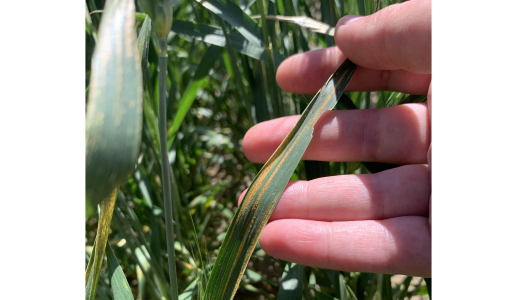 Figure 1. Characteristic symptoms of stripe rust infection: yellow-orange pustules forming in linear patterns along the length of the leaves. Photo credit: Linda Hebb, MSU. |
Stripe rust is a polycyclic disease, meaning that the pathogen will continue to produce spores, spread, and infect for as long as conditions are favorable. Optimal conditions for infection and disease development are cooler temperatures between 50 and 64 degrees F and moisture (6 hours of dew are ideal). Now that wheat plants are infected, temperature is less important for disease development, but shorter dew periods and temperatures of 90 degrees F and higher will slow the infection process.
Management Strategies
Varietal Resistance: Fortunately, we have both winter and spring wheat varieties available that are resistant to stripe rust. The last time we had significant stripe rust pressure in the state that allowed us to evaluate variety resistance to stripe rust was in 2016. Those results are summarized below. As prevalent stripe rust races shift, so may the resistance classification of currently grown varieties.
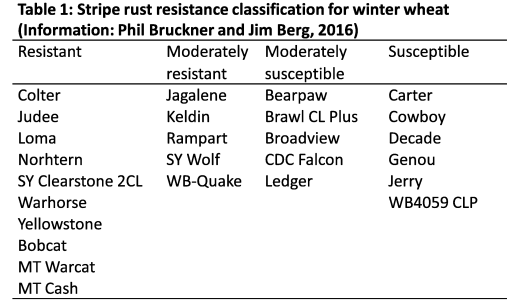 |
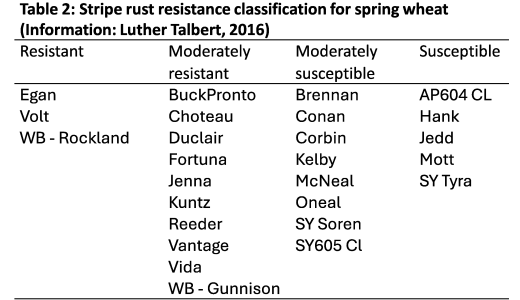 |
Stripe rust resistant varieties can express symptoms that may be mistaken for a severe rust infection when it is actually the plants resistance response to fending of the pathogen (Figure 2). You don’t need to spray resistant varieties for stripe rust.
If you do observe stripe rust resistant varieties with an active infection (yellow-orange pustules), please let us know and submit a sample to Xianming Chen at Washington State University. The stripe rust fungus can overcome existing resistances quickly and we will want to know of new stripe rust races that have overcome currently used resistance.
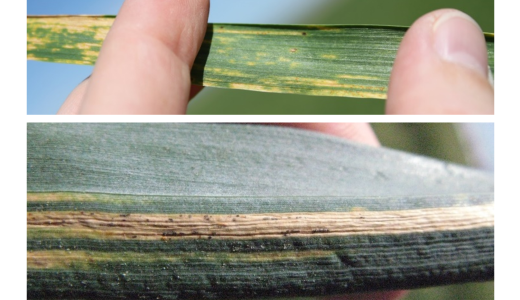 Figure 2. Linear patterns of dead plant tissue on the wheat foliage are the result of the resistance reaction of resistant plants to stripe rust. This happens because the plant is killing off the cells infected by the rust fungus to prevent its spread. Photo credit: Mary Burrows. Fungicide Applications: Timing of fungicide application will be more important than what product is used. The key is to protect the flag leaf. The later in plant development stripe rust infects, the less impact it will have on yield. The table below indicates approximate percent yield loss by leaf rust severity at different growth stages – please note this table refers to leaf rust, not stripe rust but was the most relevant data available for comparison. In looking at the second column, where the severity of rust on the flag leaf is 25% (obviously visible) and the growth stage is flowering, if you neglect to spray a fungicide to control disease you will lose 15% of the yield. If the disease level is 25% at the milk stage you lose less yield, only 5%. |
 |
Table 3 above was extracted from the full extension publication at the following link: http://lubbock.tamu.edu/files/2011/10/osufoliarfunghandout04_12.pdf.
The last stage at which you can spray a fungicide depends on the product, but is generally 30 days or flowering, Feekes 10.51. Please check your label before application to be certain you are not violating the preharvest interval.
In terms of fungicide products, there are many good options available. You can find the most updated information on fungicide efficacy for wheat rust control on the Crop Protection website Fungicide Efficacy for Control of Wheat Diseases. Carefully read the label and adhere to indicated harvest restrictions for application timing.
For questions, please contact the Schutter Diagnostic Lab or Uta McKelvy, Assistant Professor Extension Plant Pathology-uta.mckelvy@montana.edu.
###
MSU Extension

